 |
 |
| Home | Countries province | Tourism | Living History | History | Culture |
|
| The town hall of the province of Lucca Bagni di Lucca Barga Borgo a Mozzano Camaiore Castelnuovo Garf. Castiglione Garf Coreglia Antelminelli Pietrasanta Vergemoli Viareggio | Montecarlo | The countries of Montecarlo Ancient castle of Montechiari S.Piero in Campo Ancient castle of Vivinaia | |
| Montecarlo Google maps | Church of S.Andrea | ||
 |
 |
||
 |
|||
| Montecarlo country and castle of medieval origin Origin name - The country is called "Mons Charoli" (Charles' Mountain) in honor of its founder Charles IV of Boemia Church S.Andrea (XIV century) History country - The country was founded next to the ancient fortitude of the "Cerruglio" (Roman origin) in the XIV century from Charles IV of Boemia 1314 - the army of Pisa destroys the castle of S.Piero in Field and her population she is sheltered around the fortitude of the "Cerruglio" 1331 - the army of Florence in war with Lucca destroys the Castle of S.Piero in Field, its population is sheltered around the fortitude of the "Cerruglio" 1331 - Charles IV of Boemia begins the construction of a new castle around the ancient fortitude of the "Cerruglio" 1342 - Montecarlo becomes dominion in Pisa 1369 - Montecarlo returns dominion of Lucca XV century - Florence enters war with Lucca, April 28 th 1438 is signed the peace and Montecarlo it becomes dominion in Florence up to the Kingdom of Italy Photo Montecarlo Country n°1 - n°2 - n°3 - n°4 Photo Castle The boundaries of the Castle n°1 - n°2 - n°3 Door "Fiorentina" | |||
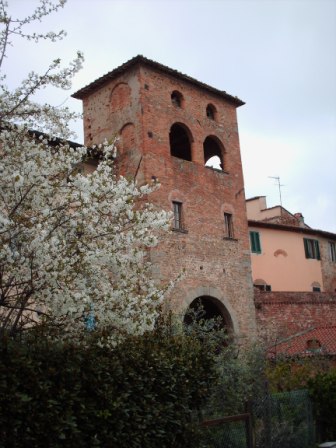 |
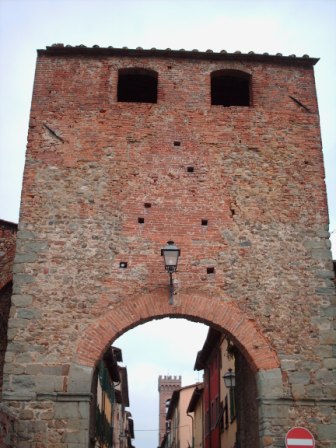 |
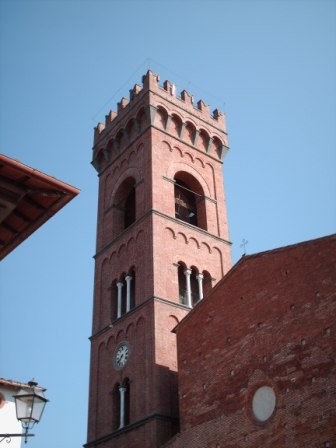 |
| Church of S.Andrea |
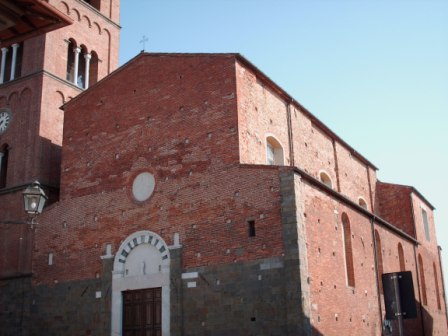 1331
Charles IV of Boemia began the construction of the new castle of
Montecarlo,
1333 The
population of Montecarlo asked through the Notary Imperial Domenico
Cenci of Baggiano to build a new church in the castle in
substitution of the old church of S.Andrea of Vivinaia, the
application she was rejected, the men of Montecarlo forwarded a new
application and January 7 th 1334 the Bishop of Lucca it welcomed
the new application and it imposed to the priest of Vivinaia to move
himself themselves to the new church of Montecarlo.
The
small long church 50 braccias and wide 25 braccias (29 xes 14
meters) with to spend some years it became more main point of
his/her Parish (Parish of S.Piero in Field) and the 29 July of the
1408 Pope Gregorio XII in visit to Lucca decided to move the
privileges of the parish of S.Piero to Field to the Church of
S.Andrea of Montecarlo.
XVIII
century - The Granduca in Tuscany I order the restructuring and the
amplification of the church, the 21 September of 1783 the Bishop
Francesco Vincenti consecrated the new church
1862 -
The church of S.Andrea of Montecarlo was embellished with some
frescos painted by the painters Pezzati Pietro and Folchi Ferdinando
1926 -
The church was again restructured
1331
Charles IV of Boemia began the construction of the new castle of
Montecarlo,
1333 The
population of Montecarlo asked through the Notary Imperial Domenico
Cenci of Baggiano to build a new church in the castle in
substitution of the old church of S.Andrea of Vivinaia, the
application she was rejected, the men of Montecarlo forwarded a new
application and January 7 th 1334 the Bishop of Lucca it welcomed
the new application and it imposed to the priest of Vivinaia to move
himself themselves to the new church of Montecarlo.
The
small long church 50 braccias and wide 25 braccias (29 xes 14
meters) with to spend some years it became more main point of
his/her Parish (Parish of S.Piero in Field) and the 29 July of the
1408 Pope Gregorio XII in visit to Lucca decided to move the
privileges of the parish of S.Piero to Field to the Church of
S.Andrea of Montecarlo.
XVIII
century - The Granduca in Tuscany I order the restructuring and the
amplification of the church, the 21 September of 1783 the Bishop
Francesco Vincenti consecrated the new church
1862 -
The church of S.Andrea of Montecarlo was embellished with some
frescos painted by the painters Pezzati Pietro and Folchi Ferdinando
1926 -
The church was again restructured
|
| Photo curch n°1 - n°2 - n°3 - n°4 |
| The countries of Montecarlo |
| Ancient castle of Montechiari S.Piero in Campo Ancient castle of Vivinaia |
| Ancient castle of Montechiari |
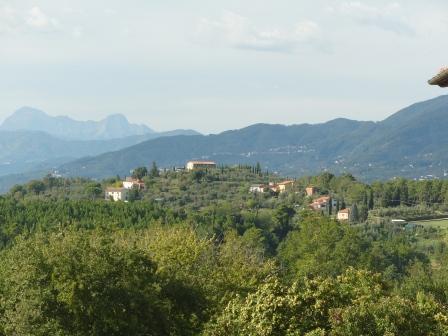 The
castle of Montechiari, disappeared today as the castle of
Vivinaia, it rose on the summit of a hill, near Montecarlo to
little distance from the Fortitude of the Cerruglio and for its
position exposed to the sun of midday (as it tells the
Anzillotti in its history of the Valdinievole) that you was
called "Montechiaro." The
castle of Montechiari, disappeared today as the castle of
Vivinaia, it rose on the summit of a hill, near Montecarlo to
little distance from the Fortitude of the Cerruglio and for its
position exposed to the sun of midday (as it tells the
Anzillotti in its history of the Valdinievole) that you was
called "Montechiaro."Of his nobles and of her history before Thousand we know few, in the XI century the castle results in the hands of the Accounts of Montechiari and Uzzano, surname of origin Longobardas, Ancient friends of Lucca also participated in the government of the city, among the first Lords of the castle of whom we have news it exists a certain Sisemondo of Sichelmo together with the child of a certain Rolando of Sisemondo. during the war between Guelfi and Ghibellini, the Lords of Montechiari allied of the first faction began to fight with the near castles, friends of the Ghibellinas, among which the castle of Buggiano, castle that together with their allies (Altopascio, Vivinaia and Cerruglio) they tried to conquer failing the assault, the men of Montechiari to avenge the defeat recruited Romano from said Cerraia "La Forte Spada", bandit and mercenary to the penny of whom paid better it, after having received some reinforcements from Lucca, "Forte Spada" a night assaulted the castle of Buggiano gathering of surprised the sentinels and its population, his men once entered the castle, burned the country killing the population. In 1314, the pisano Uguccione of the Faggiola penetrated in Valdinievole, after having burnt and destroyed the country of "S.Piero in Field" it assaulted the fortitudes of the Cerruglio, Vivinaia and Montechiari, these last two to the arrival of the soldiers of Pisa were abandoned from her population, the survivors they hid him near the lake of Bientina. In 1323, the army of Florence and Pistoia in war with the noble of Lucca Castruccio Castracane, exploiting the numerical superiority (around 20.000 pedestrians and 3.000 riders) they succeeded in conquering the castles of Montecarlo, Montechiari and Porcari, Castruccio sheltered him to Pistoia was helped by the soldiers of Galeazzo Visconti and he succeeded in freeing the castles and to defeat the hostile army in the battle fought near to Altopascio. The castles of the Valdinievole September 28 th 1328 to free themselves from the dominion of lucca they founded her "League of the castellas of the Valdinievole", but the castle of Montechiari remained under the dominion of Lucca Two years later, in September 1330 the Florentines assaulted and they again conquered Montechiari, but in 1332 they were chased by the troops of Charles IV I give birth of King Giovanni of Boemia, that began the construction of a new castle (the actual Montecarlo) erect around the fortitude of the Cerruglio, the population of Montechiari, began to migrate toward Montecarlo beginning the decline of the ancient castle of Montechiari, that will disappear after being definitely ended in 1437 under the jurisdiction in Florence during the centuries |
| S.Piero in Campo |
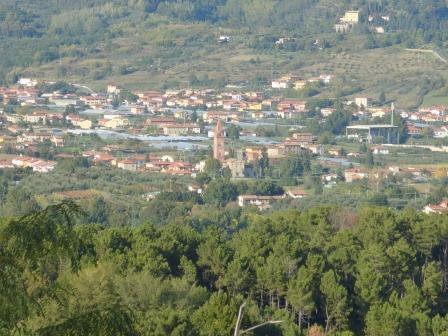 The
origins of S.Piero in Field him unfortunately pardon in the
night of the times and the lack of documentation has not allowed
the historians to establish a precise period, the most ancient
news refers to its church her "Parish of S.Piero in Field", one
of the most ancient churches in the province of Lucca,built
before the fall of the Roman empire next to two Roman temples,
destroyed with the Christianity's arrival in the region, the "Fanum
Martis" near the Castrum Veneri and the "Temple of the gods Lari"
(for further information Parish of S.Piero in Field).
This Roman presence, installed him near the
two rivers Pescia Minore and Pescia Maggiore (or of Collodions),
she can induce to hypothesize the formation of a first small
Roman urban agglomeration, but it is also true that the first
churches, were built even if isolated mainly in the streets of
communications in places easily accessible to the people,
therefore we can also make to go up again the birth of the
suburb to the building of its castle, one of the most ancient of
the Valdinievole, founded according to some The
origins of S.Piero in Field him unfortunately pardon in the
night of the times and the lack of documentation has not allowed
the historians to establish a precise period, the most ancient
news refers to its church her "Parish of S.Piero in Field", one
of the most ancient churches in the province of Lucca,built
before the fall of the Roman empire next to two Roman temples,
destroyed with the Christianity's arrival in the region, the "Fanum
Martis" near the Castrum Veneri and the "Temple of the gods Lari"
(for further information Parish of S.Piero in Field).
This Roman presence, installed him near the
two rivers Pescia Minore and Pescia Maggiore (or of Collodions),
she can induce to hypothesize the formation of a first small
Roman urban agglomeration, but it is also true that the first
churches, were built even if isolated mainly in the streets of
communications in places easily accessible to the people,
therefore we can also make to go up again the birth of the
suburb to the building of its castle, one of the most ancient of
the Valdinievole, founded according to some
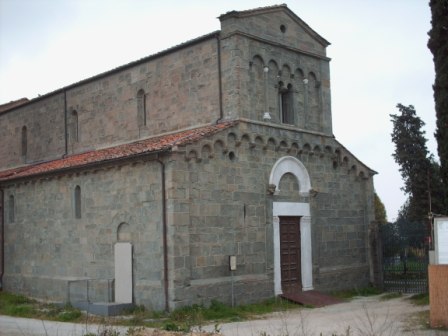 local
historians (Anzilotti), from the Goths around the
V century.
The suburb situated in the ancient place "Marcoratico",
taken the name from "Field of the Pescia" (the ancient name of
the Valdinievole) and you is quoted for the first time in a
document of donation dated 1058 performed by a certain Guinigio.
(the antecedent documents to this date remember only the
Parish).
During the war of the XIV century that spread
in Valdinievole, the noble of Pisa Uguccione of the Faggiola
penetrated in the valley with his/her army, destroyed and burned
S.Piero in Field (1314), forcing to the escape the whole
population, that hid him in the new castle of Montecarlo built
by Charles IV of Boemia in the following years, marking the
decline of the suburb that won't disappear as other near suburbs
during the centuries.
In 1328 his castle trying to escape to the dominion of Lucca, it
entered to belong to the "League of the castles of the
Valdinievole" and together in other twelve castles of the
valley, churches help to the army of Florence, but only in 1437
it will definitely end under the jurisdiction in Florence local
historians (Anzilotti), from the Goths around the
V century.
The suburb situated in the ancient place "Marcoratico",
taken the name from "Field of the Pescia" (the ancient name of
the Valdinievole) and you is quoted for the first time in a
document of donation dated 1058 performed by a certain Guinigio.
(the antecedent documents to this date remember only the
Parish).
During the war of the XIV century that spread
in Valdinievole, the noble of Pisa Uguccione of the Faggiola
penetrated in the valley with his/her army, destroyed and burned
S.Piero in Field (1314), forcing to the escape the whole
population, that hid him in the new castle of Montecarlo built
by Charles IV of Boemia in the following years, marking the
decline of the suburb that won't disappear as other near suburbs
during the centuries.
In 1328 his castle trying to escape to the dominion of Lucca, it
entered to belong to the "League of the castles of the
Valdinievole" and together in other twelve castles of the
valley, churches help to the army of Florence, but only in 1437
it will definitely end under the jurisdiction in Florence
|
| Ancient castle of Vivinaia |
| The origin of the by now disappeared castle of Vivinaia, situated to few hundred meters by the fortress of the Cerruglio (Montecarlo), it goes up again to the dark times of the medioevo, despite the absence of a precise documentation on its antecedent history to the XI century, the historical searches done by some historical ones, among which the Baldasseroni would do him go up again to the V century when the Goths to defend their earths in Valdinievole, in some strategic points they built you some fortifications. The available documentation regarding Vivinaia, first "Curtis"magravale and then castle, part from the X century to end himself in the XIV century with her destruction, in the first documents arrivals to our days her "Curtis de Vivinaia", in the XI century resulted to be one "Earth" very important and able to welcome inside its buildings illustrious characters the first Emperor to venir entertained for some days in 1022 from the Marquis Ranieri was Henry II, Duke of Baviera and King of Germany (Brass successor III, become Emperor of the empire of west in 1002), while in 1038 the Marquis Bonifazio of Canossa (father of Matilde of Canossa) it entertained you Pope Benedetto the Ninth and the emperor Corrado II, with the whole court. In 1075 news of the happened transformation of the is had "Curtis" in the castle, through a donation of "Earths" you rent in the plan of Pescia, for the monastery of S.Martino in Colle "Cartula Offersionis", compiled by the imperial notary Ildebrando "Intus Castre De Vivinaia". In the November of 1197 to St. Ginesio, to the presence of the cardinal Bernard, Lucchesi and Pandolfo Roberti, some suburbs and castles of the "Tuscia" pushed by the Bishops and by the Accounts of the regions they gave life to one "League Guelfa", with the intent to isolate the cities Ghibelline Pisa, Siena and Pistoia, trying to bring her under the papal influence, Vivinaia insieme to some near castles (Cerruglio, Montechiari), In the November of 1197 to St. Ginesio, to the presence of the cardinal Bernard, Lucchesi and Pandolfo Roberti, some suburbs and castles of the "Tuscia" pushed by the Bishops and by the Accounts of the regions they gave life to one "League Guelfa", with the intent to isolate the cities Ghibelline Pisa, Siena and Pistoia, trying to bring her under the papal influence, Vivinaia 5 years later it participated together you to some near castles for some quarrels among the two line up happened in the castle, the majority Ghibellina (winning) under the command of a certain Gherardo joined him the republic in Pisa. The adhesion to the "League Guelfa" it caused a series of disputes and controversies with some near castles, as it happened in 1261, when the Commune of Lucca threatened by the strengths Ghibelline to strengthen the defenses in Valdinievole, diverted the course of the rivers Pescia Minore and Pescia Maggiore flooding the oriental sector of the underlying valley Vivinaia. With the ascent to the power of Castruccio Castracane to Lucca, Vivinaia changed flag, from fortress Guelfa became fortress Ghibellina, Castruccio considered the castles of Vivinaia, called "Castle Lucchese" and the castle of S.Martino in called Hill "Castle Ghibellino" essential fortitudes for the defense of Lucca in the war with Florence, and for the assistance to the troops of Lucca penetrated in the allied territories of the Florentines, the castle of Vivinaia resulted fundamental in 1325 when the army of Florence under the command of the general Cadorna entered the territories lucchesi, crossing the place "the Cerbaies" assaulting the castle of Altopascio, protected Castruccio from the castles of Vivinaia and the Cerruglio withdrew some troops lined up to Pistoia and directing the war operations from that hill on September 23 counterattacked together with his/her allies Ghibellini lombardi inflicting a hard defeat to the Florentines in the battle fought in the inclusive lowland between Porcari and the Abbazzia of Pozzeveri, the winning army of Lucca it captured many prisoners, among which also the general Raimondo Cadorna. With the sudden death of Castruccio for malaria (or poisoning), Lucca fell in the chaos, and the Florentines took advantage of it and in the September 1330 headed by Alamanno of the Obizzis, "rebellious " lucchese of part Guelfas, penetrated in the earths of Lucca succeeding in camping themselves under the boundaries of the city, Noble Spinola of Lucca asked help to Giovanni king of Boemia and king of Poland, come in lombardia, King Giovanni intervened sending the 1 March of 1331 to Lucca his/her prefect Real Simone Filippi of Pistoia with 800 riders, the army of Florence withdrew him crossing the Valdinievole, burning and destroying the castle of Vivinaia |
| Contado Lucchese | Contacts |